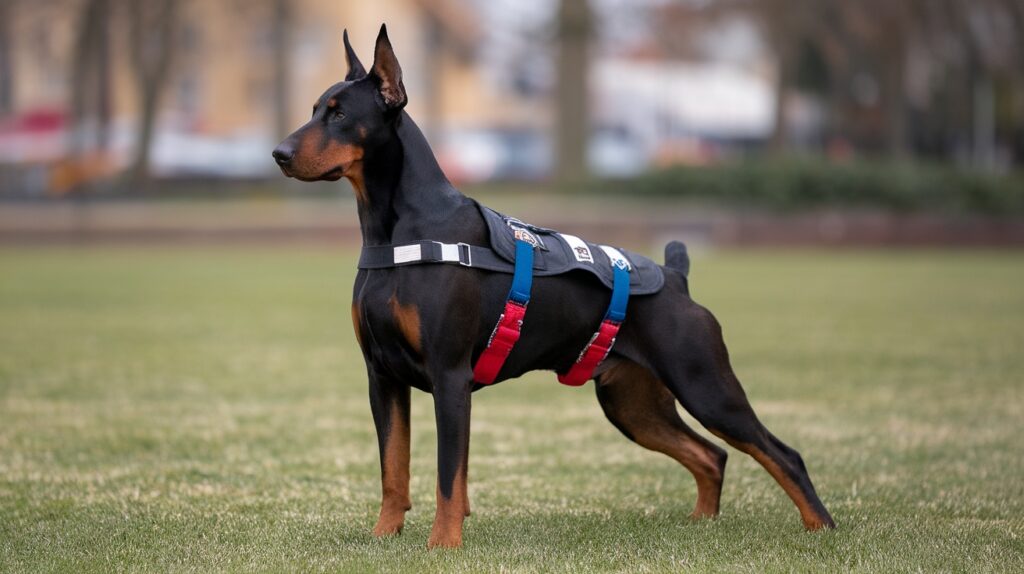Training a Doberman takes structure, patience, and clear guidance. This intelligent, energetic breed thrives when it knows what’s expected.
With the right discipline techniques, a Doberman can grow into a well-mannered companion who understands boundaries and responds with confidence.
A thoughtful approach to discipline doesn’t mean harshness. Instead, it means setting rules, staying consistent, and using strategies that fit the Doberman’s natural drive to learn.
By focusing on structure and calm direction, anyone can build a strong bond while shaping reliable behavior.
Establish Clear Rules and Boundaries
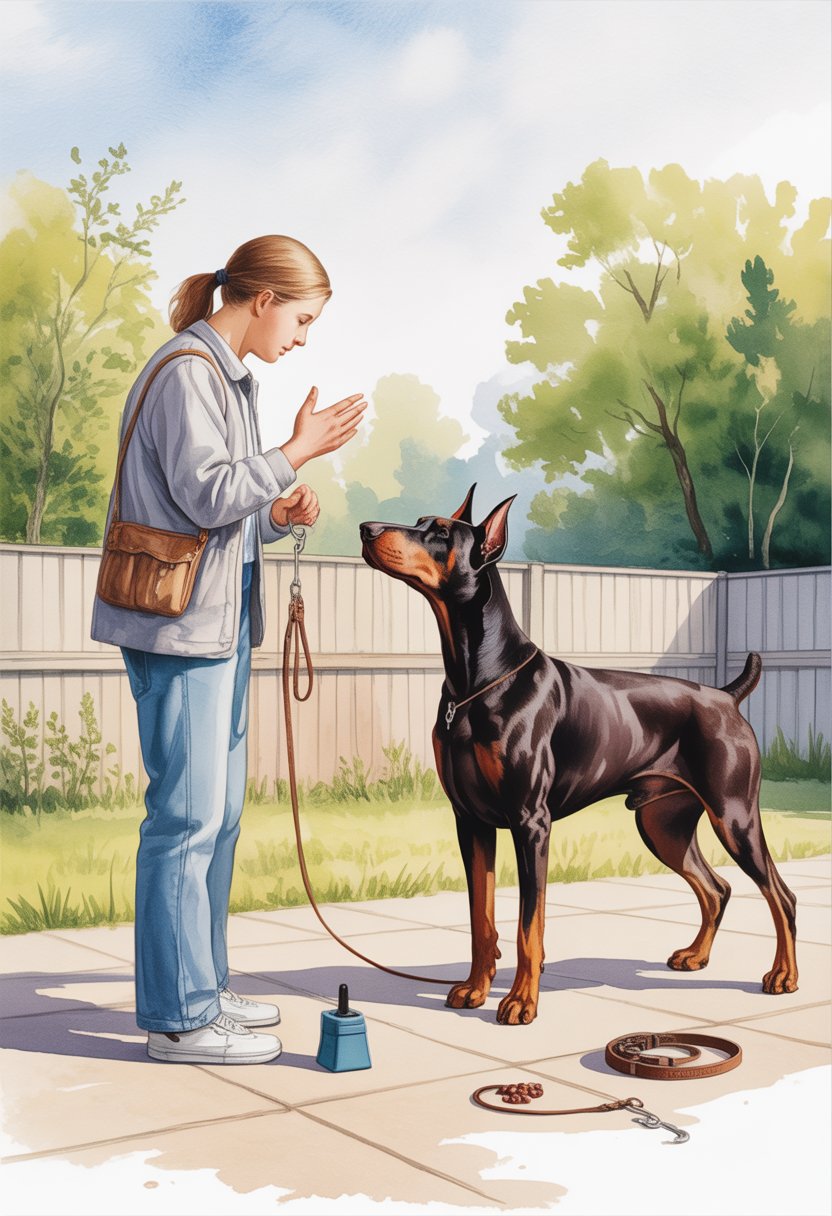
A Doberman feels more secure when it knows what’s expected. Clear rules give structure and help prevent confusion during training.
Without boundaries, the dog might test limits and develop unwanted behaviors. Owners should decide early which behaviors are okay and which aren’t.
For example, if jumping on furniture isn’t allowed, keep that rule the same every day. Consistency prevents mixed signals.
Dobermans learn faster when the same commands and routines are used. Changing rules or ignoring misbehavior can cause setbacks.
Boundaries also build respect between the dog and owner. A Doberman that understands limits is less likely to challenge authority.
Simple steps, like using the same words for commands and setting clear household rules, create a stable environment. Over time, the dog learns what’s expected and feels more confident following direction.
Use Consistent Verbal Commands

Dobermans respond best when they hear the same words for the same actions. If you sometimes say “sit” and other times “sit down,” the dog may get confused.
Clear, steady language helps the dog connect the command to the behavior. Avoid changing tone or volume too much.
A calm, firm voice works better than shouting or whispering. Dogs learn to link the sound of the word with what you expect.
Short, simple words make training easier. Commands like “sit,” “stay,” and “come” are easier for the dog to recognize.
Pairing words with hand signals can strengthen understanding. For example, saying “stay” while holding up a flat hand helps the dog connect both cues.
Consistency from everyone in the household matters, too. If one person uses “down” and another says “lie,” the dog may struggle to follow.
Incorporate Visual Cues with Commands
Dobermans do well when they can connect a word with a clear action. Using both a voice command and a hand signal helps them understand what you want.
For example, when teaching “sit,” you can say the word while moving your hand downward. The dog starts to link the sound with the motion.
Visual cues help in busy or noisy areas where a dog might not hear you. A simple hand signal can guide them without confusion.
Consistency matters most. Using the same gesture for each command keeps things clear.
With steady practice, Dobermans learn faster and show more reliable obedience.
Apply Positive Reinforcement Regularly
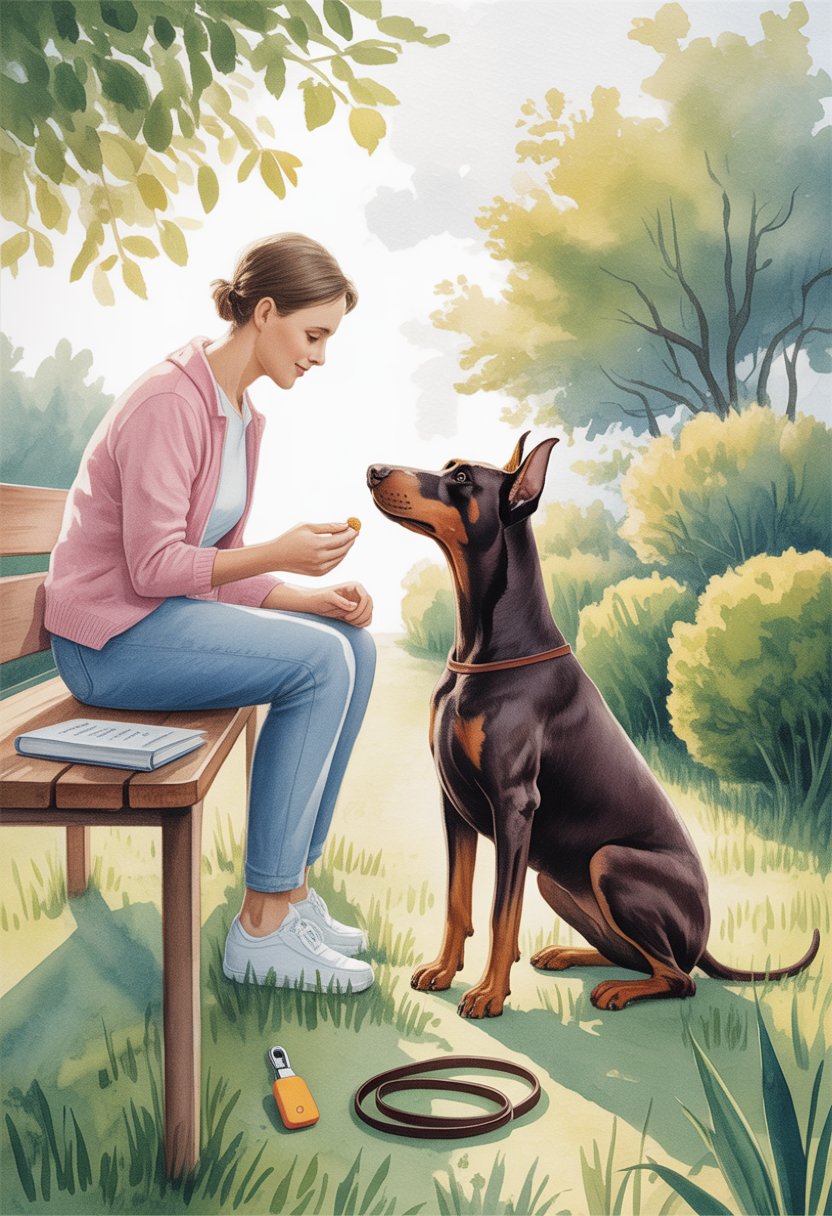
Positive reinforcement helps Dobermans learn what behaviors earn rewards. When they sit, stay, or follow a command, giving a treat, praise, or playtime shows them they did the right thing.
They respond best when rewards come right after the desired behavior. Consistency matters, so always reward good actions in the same way.
Using positive reinforcement also strengthens trust between the Doberman and their owner. Instead of focusing on punishment, the dog learns to look forward to training sessions.
Rewards don’t always need to be food. Some Dobermans enjoy toys, petting, or verbal praise just as much.
Mixing up rewards keeps training interesting and prevents the dog from losing focus. By applying positive reinforcement regularly, you guide your Doberman toward good habits and keep the bond strong.
Implement Time-Outs for Undesired Behavior

A time-out gives a Doberman a short break from attention or play when they show unwanted behavior. This works best when you use it calmly and without anger.
Guide the dog to a quiet, safe spot for a few minutes. The area should be free from toys or distractions.
If the Doberman repeats the behavior, calmly return them to the time-out area. This steady response helps the dog learn which actions aren’t acceptable.
After the time-out, let the dog rejoin normal activity. Notice and reward positive behavior so the dog learns what earns attention.
Keep Training Sessions Short and Frequent
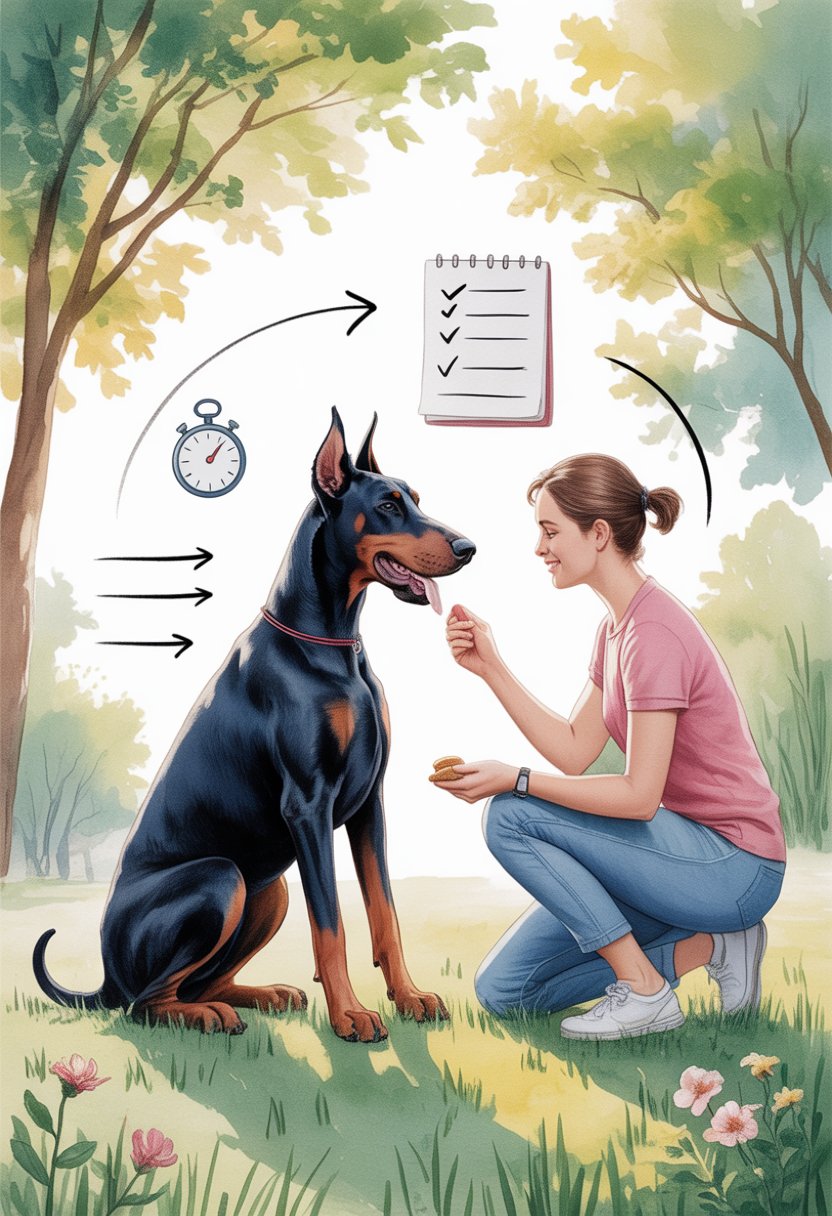
Dobermans learn best when training sessions stay brief. Long lessons usually cause them to lose focus.
Keeping sessions under 15 minutes helps maintain attention. Short bursts of practice let the dog stay engaged without getting bored.
Frequent practice throughout the day works better than one long session. A few short lessons spread out give the dog more chances to succeed.
Mixing up activities during these short sessions helps, too. Changing commands or adding small challenges keeps the dog interested.
Regular breaks between lessons give the Doberman time to process what it learned.
Start Training Early with Puppies
Training should start as soon as a Doberman puppy comes home, usually around 8 weeks old. At this age, they’re curious and open to learning simple rules.
Early lessons help shape good habits before unwanted behaviors set in. Puppies respond best to short, positive sessions.
Using rewards like treats, toys, or praise helps them connect commands with good outcomes. Keeping training fun encourages them to stay engaged.
Socialization is just as important as obedience. Introducing the puppy to new people, sounds, and places builds confidence and reduces fear later in life.
Consistency matters from the start. Using the same cues and routines teaches the puppy what to expect.
Starting early also builds trust between the puppy and their family. With steady practice, puppies grow into well-mannered Dobermans.
Maintain a Structured Daily Routine
A Doberman feels more secure when daily life follows a clear pattern. Regular times for meals, walks, and training sessions help the dog know what to expect.
Short, consistent training periods fit well into a daily schedule. Ten to fifteen minutes at a time keeps the dog focused.
Exercise should also follow a routine. Scheduled walks and play sessions give the Doberman a healthy outlet for energy.
A predictable schedule helps prevent restlessness and unwanted behavior in the home. Rest is just as important as activity.
Setting aside quiet times during the day teaches the dog when to settle down. This balance between active and calm periods supports steady progress.
Use Interactive Toys to Stimulate Mind
Interactive toys give Dobermans a healthy way to use their energy and focus. These toys challenge their problem-solving skills and keep them from getting bored.
Puzzle toys, treat-dispensing balls, and toy-naming games encourage them to think while they play. The dog learns to work through small challenges to earn a reward.
Toys that involve scent work, like hiding treats inside compartments, engage their natural instincts. This type of play helps them use their nose and brain together.
Rotating different toys keeps things fresh and prevents the dog from losing interest. Short, regular play sessions with interactive toys provide steady mental stimulation and support good behavior.
Practice Patience and Stay Calm
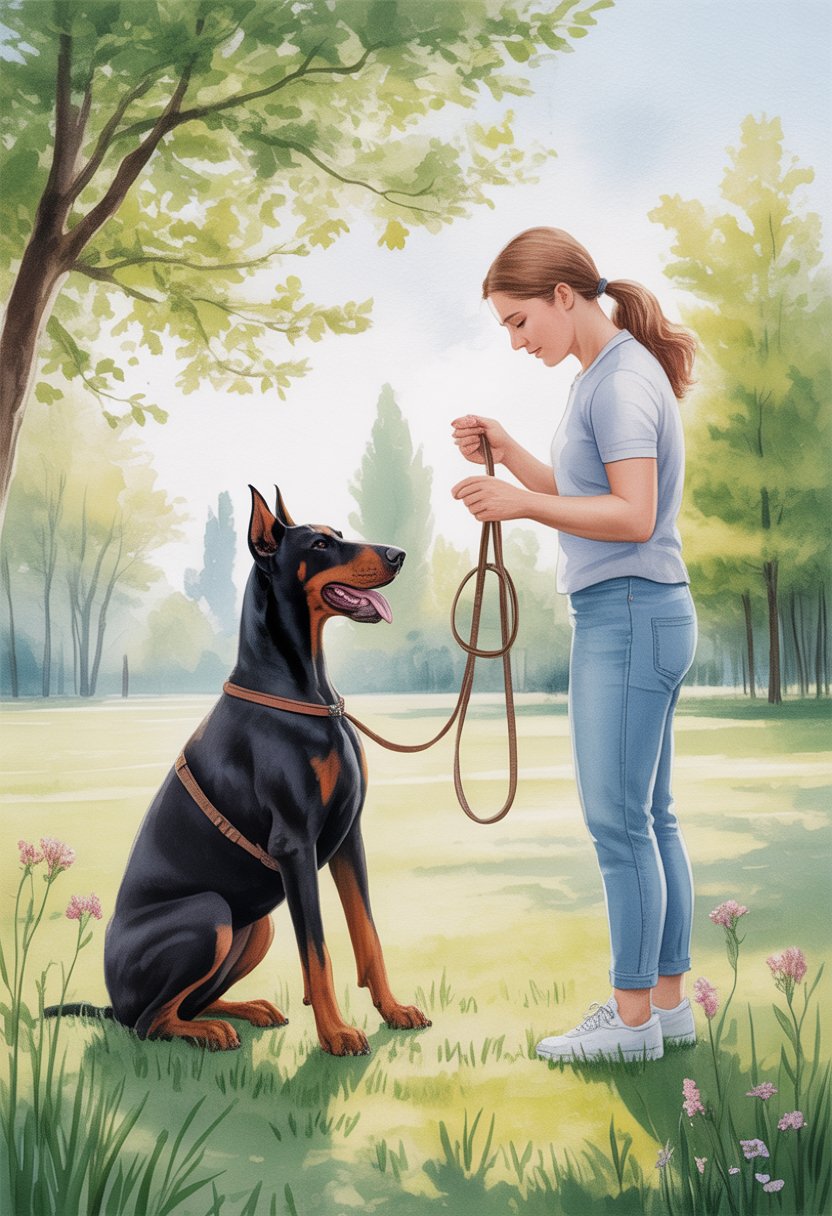
Training a Doberman takes time. Progress probably won’t happen overnight.
They’re smart dogs, but every Doberman learns at its own pace. Staying calm helps your dog feel secure and focused during lessons.
If your Doberman makes mistakes, reacting with frustration can confuse or scare them. A calm response gives your dog space to try again without pressure.
Short, consistent sessions usually work better than long, stressful ones. When you keep training relaxed, your dog stays engaged and willing to learn.
A calm tone of voice and steady body language matter, too. Dogs pick up on human emotions, and they often mirror that energy.
When you stay composed, your Doberman is more likely to stay attentive and cooperative. It might feel slow sometimes, but patience really does make the process smoother for both of you.
Understanding Doberman Behavior
Dobermans are intelligent, energetic, and loyal. They respond best to structure and consistency.
Their behavior often reflects a strong drive to protect, bond with family, and stay active. You can see it in the way they shadow your every move.
Breed-Specific Traits
Dobermans were bred as working dogs, so they’re alert and highly trainable. Many form strong attachments to their owners and will follow you from room to room.
That loyalty can be wonderful, but it also means they don’t like being left alone for long. Some Dobermans really struggle with separation.
They’re naturally protective and can act wary around strangers. Proper socialization helps them learn how to respond calmly in new situations.
Without enough socialization, they might get overly suspicious or anxious in unfamiliar places. It’s not their fault—it’s just their instinct.
Energy levels run high in this breed. They need both physical exercise and mental challenges to stay balanced.
Activities like obedience, agility, or puzzle toys keep them focused. Otherwise, boredom can lead to some pretty annoying behaviors.
Since they’re quick learners, Dobermans pick up commands fast. But they also notice if you’re inconsistent.
Clear rules and steady routines help them feel secure and cooperative. It’s not always easy, but it’s worth it.
Common Training Challenges
A Doberman’s intelligence sometimes leads to stubbornness. If training gets repetitive or boring, they’ll lose focus.
Keeping lessons short, varied, and rewarding helps hold their attention. You might have to mix things up more than you’d expect.
Their protective nature can make them bark or react strongly to noises or strangers. Teaching controlled responses through exposure and positive reinforcement helps reduce those overreactions.
Some Dobermans test boundaries, especially during adolescence. Consistent rules, calm corrections, and rewards for good behavior prevent habits like jumping, leash-pulling, or ignoring commands.
Separation anxiety can be tough, too. Gradually building independence—like leaving for short periods and rewarding calm behavior—can make a big difference.
Maintaining Consistency in Training
A Doberman learns best when rules stay the same and rewards follow a predictable pattern. Consistency helps your dog understand what’s expected and keeps things from getting confusing.
Establishing Clear Boundaries
Clear boundaries give a Doberman structure and reduce unwanted behavior. Your dog should know where it’s allowed to go, what it can play with, and how to behave around people.
You can set these boundaries with simple rules, like:
- No jumping on furniture unless invited
- Sit before receiving food
- Stay calm before going outside
When everyone in the house follows the same rules, your Doberman learns faster. If one person allows jumping and another corrects it, your dog just gets mixed signals.
Boundaries should cover social interactions too. For example, your dog shouldn’t rush strangers or pull on the leash.
Setting these limits early prevents bigger problems as your dog grows stronger and more confident. Consistency in tone and body language is also key.
A calm, firm voice paired with steady gestures makes commands easier for your Doberman to follow. It takes some effort, but it pays off.
Reinforcement Schedules
Reinforcement keeps training effective. It motivates the Doberman to repeat good behavior.
At first, hand out rewards every time the dog does the right thing. That clear link helps your dog figure out what actually gets them praise.
Later on, you can start mixing things up. Instead of a treat every single time, try tossing in some verbal praise, a quick scratch behind the ears, or just the occasional treat.
This mix keeps the dog engaged. You’re less likely to end up with a Doberman that only listens for snacks.
A sample reinforcement plan:
| Stage | Reward Type | Frequency |
|---|---|---|
| Early training | Treats + praise | Every correct action |
| Intermediate | Treats + praise | Every 2–3 actions |
| Advanced | Praise + play | Random, unpredictable |
Gradually adjusting rewards keeps motivation up. It helps build reliability without making the training feel stale or predictable.

